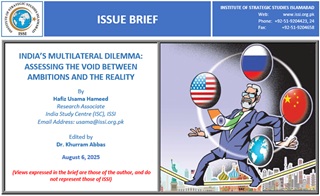Introduction
In a global environment marked by uncertainty and intensified quest for influence, the world is also witnessing a drift towards multipolarity. Multiple power-centers are emerging with rising and resurgent powers, and alignments are taking different shapes and forms. While these powers demand a bigger role in the global governance structures, whether political or economic, the status quo powers are seeking to arrest the fast-shifting sands.
Lately, India has been trying to project itself as a power way beyond its actual capabilities. Imbued with historical and civilizational claims to represent the voice of the oppressed, the quest to wrest a leadership role at the global level has been part of Indian efforts since the time of Jawaharlal Nehru.[1] With turning tides in the recent decades, India has been systematically peddling the narrative of ‘leading’ the ‘Global South.’ New Delhi has been using myriad of bilateral and multilateral platforms to advance this proposition. Organizations such as the BRICS and SCO are crucial in the context of India’s attempts to project itself as a ‘rising’ power and stake its claim for an enhanced share in an emerging power structure. In parallel, however, India has been focused on maintaining close collaboration with the Western bloc led by the United States. Simultaneously, New Delhi never tires of touting the “strategic autonomy” mantra, while riding two distinctly different boats.
Read More
